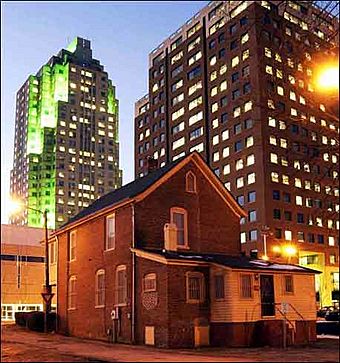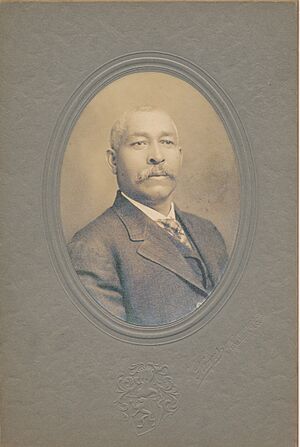Pope House Museum facts for kids
Quick facts for kids |
|
|
Dr. M.T. Pope House
|
|
 |
|
| Location | 511 S Wilmington St., Raleigh, North Carolina |
|---|---|
| Area | 0.1 acres (0.040 ha) |
| Built | 1900 |
| Architectural style | Two-story gable front |
| NRHP reference No. | 99001392 |
| Added to NRHP | November 22, 1999 |
The Pope House Museum is a special house in Raleigh, North Carolina. It was built in 1901. This house used to belong to Dr. Manassa Thomas Pope. He was an important African-American leader in Raleigh. The Pope House was added to the National Register of Historic Places in 1999. This means it's a very important historical site.
The house was part of the Save America’s Treasures Program. In 2012, the city of Raleigh started managing the museum. This allowed people to take tours of the house for the first time.
Contents
History of the Pope House
The area where the Pope House stands has changed a lot. This has been happening since the early 1800s. At first, people thought fancy homes would be built there. This was because the governor's first mansion was nearby.
Some large homes were built by white families. But in 1870, Reverend Henry Martin Tupper moved Shaw University to the neighborhood. Many African-American residents then moved to Raleigh. They settled in this area after the Civil War. Dr. Pope studied medicine at Leonard Medical Center at Shaw University. After that, he started his medical practice.
Building a Home in the Third Ward
African-American professionals began building homes in this area. It was known as the Third Ward. This included the 500 block of South Wilmington Street. In 1901, Dr. Pope decided to build his house there.
His neighbors were also important African Americans. They included another doctor and a pharmacist. Dr. Pope's home was close to his office. His office was on East Hargett Street. This street was the center of the black business district at that time.
Modern Features of the House
Dr. Pope made sure his home had the newest technology. It had lights that could use both gas and electricity. The kitchen had running water. There was a full bathroom upstairs. The house was heated by coal-burning stoves. It even had a telephone.
He also put in a call bell system. There were buttons in each room. A special device in the back hall would show which room was calling. In the 1920s and 1930s, Dr. Pope's health started to decline. He began seeing patients in his home. A small area near the kitchen was set up for this. It had a small sink and a cabinet for medical tools.
Family Life and Changes Over Time
Dr. Pope married Delia Haywood Phillips in 1907. After they married, they added a garage. They also wired the whole house for electricity. In the 1920s, the original front porch was removed. A new "sleeping porch" was built in its place.
In the 1940s, part of the space under the porch was enclosed with bricks. It still looks that way today. Dr. Pope and Delia had two daughters, Evelyn and Ruth. After their parents passed away, Evelyn and Ruth kept the family home. Even though they lived in Durham and Chapel Hill, they took care of the house.
The Neighborhood Changes
The Pope House is still in its original neighborhood. However, the area around it has changed a lot. Older homes and businesses were replaced. Now there are office buildings, parking lots, and newer homes. A big change was the building of the Raleigh Convention Center. It is directly across the street from the house. Today, tall buildings from the 1980s and 1990s stand around the house.
Becoming a Museum
The Pope House was officially added to the National Register of Historic Places on November 22, 1999. The next month, the Pope Charitable Foundation decided to turn the house into a museum. One month later, The Pope House Museum Foundation became a non-profit organization.
The family's many papers were organized and given to the Southern Historical Collection. This collection is at the University of North Carolina at Chapel Hill. In 2011, the Pope House Museum faced money problems. They asked the city of Raleigh to buy the house. This would help make sure the museum could continue.
The city bought the house. Now, Raleigh Parks and Recreation manages the Pope House Museum. They opened it for regular tours for the first time.
See also




